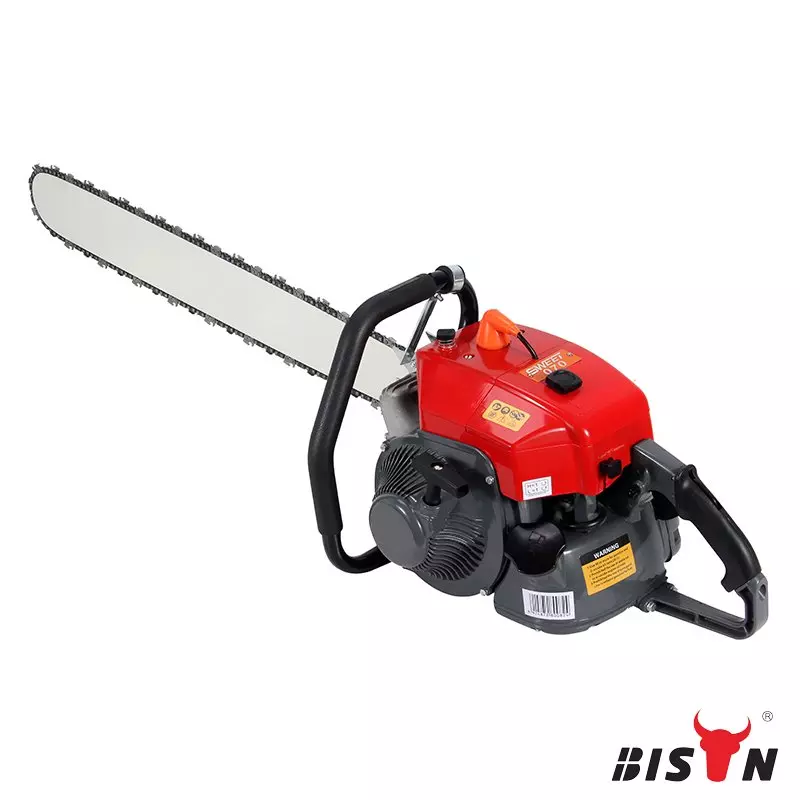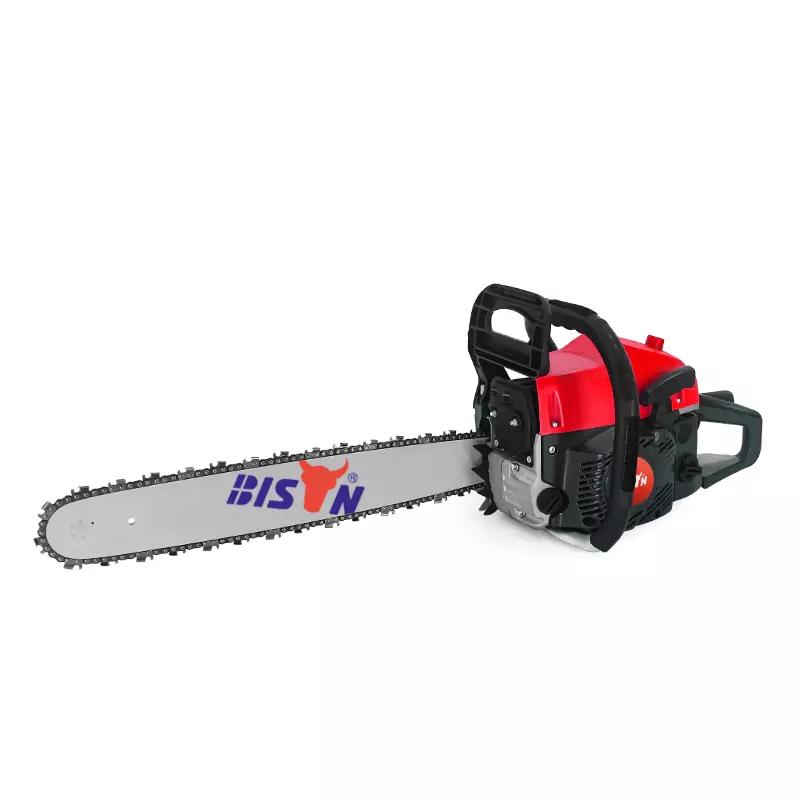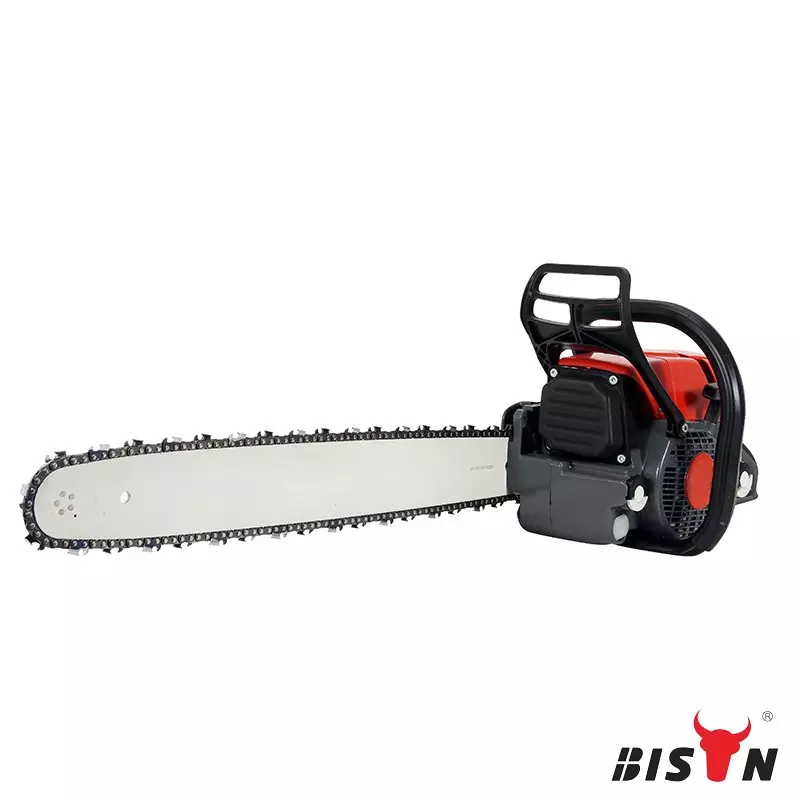Top handle vs. rear handle chainsaws: Choosing the right tool
2024-02-28
Table of content
Chainsaws are versatile and powerful tools that demonstrate a wide range of applications, from chopping firewood in the winter to aiding professional loggers or assisting arborists in the canopy. However, as technology has advanced, they have been fine-tuned to serve specific purposes and classified based on various factors, including power source, cutting capacity, safety features, and even handle configuration.
The handle configuration—specifically the difference between the top handle and rear handle chainsaws—is more than an aesthetic change. This seemingly simple change greatly affects the usability, safety, application diversity and overall chain saw performance.
Through this article, BISON aim to guide you through the fundamental differences between top and rear handle chainsaws, the unique advantages of each, and its intended use. This will allow you to differentiate between these chains and choose the most suitable one for your project.

What is a top-handle chainsaw?
A top handle chainsaw, as suggested by its name, is designed to have the handle positioned on the top of the chainsaw. It is also called climbing chainsaws because trained arborists typically use them when climbing trees.
The top handle chainsaw is designed to be operated off the ground, even with one hand. In such chainsaws, the throttle control is mounted near the top handle. This configuration is accompanied by a compact design which, when coupled with the handle's placement, not only enhances control over the saw but also allows easy maneuvering.. However, using a chainsaw with one hand is not a good practice for safety reasons.
Advantages of top handle chainsaws
On the bright side, their unique design gives users superior control, especially in tight spaces. This is due to the direct line of sight, facilitated by holding the tool from above, which significantly simplifies the precision requirements of certain tasks. Additionally, the convenience of maneuverability allows these chainsaws to be operated from various angles.
Disadvantages of top handle chainsaws
Despite the advantages, there are some domains in which the use of top-handle chainsaws may be challenging.
This type of saw uses more power to operate. This will, without a doubt, produce wonderful results. However, this will come at a purchase price that is often high. The design of top handle chainsaws usually necessitates two-handed operation to maintain control and balance, which can limit their usage in some scenarios. It will be challenging for novices or those with insufficient knowledge and expertise to comprehend and become proficient with these saws. This further increases the usage cost.
Application of top handle chainsaws
This is quintessential in scenarios that demand precision cutting or navigating through narrow spaces. It's a tool of choice for arborists when tree-pruning, navigating dense tree crowns, or trimming off branches while perched high off the ground. But there may be better choices for small, daily mowing and limbing applications than using these chainsaws.
What is a rear handle chainsaw?
Now let’s turn our attention to the rear handle chain saw, whose main handle is located at the rear of the unit. So, two hands are required to hold this chain properly. The handle assembly is typically wrapped around the motor housing to provide the user with an ergonomic and sturdy grip, especially during heavy-duty operation.

advantages of rear handle chainsaws
Better handling: The first is that they have better leverage because of their rear handle. With this setup, the chainsaw may be spun while cutting by gripping the upper handle as a fulcrum.
Beginner-friendly: Unlike top-handle chainsaws, these do not require a high level of experience. Even a novice can quickly become comfortable and use the saw. Its operating costs are also generally cheaper.
disadvantages of rear handle chainsaws
However, any tool has its limitations. In some areas, these chainsaws may not be appropriate, as discussed below:
Use of both hands: You will need to use both hands to use this type of saw. It isn't easy to operate them with only one hand. This means it is almost impossible to do anything else simultaneously with the other hand. These can be more tiring than top-handle saws.
Limited scope: You can only handle ground applications with this saw, nothing else. Rear-handle chainsaws are larger and bulkier. Their size also makes them unsuitable for tight spaces or working at heights. While these chainsaws can perform heavy-duty tasks, they lack the flexibility required for more complex operations.
applications of rear handle chainsaws
The strength and stability exhibited by these chainsaws make them ideal for large, heavy-duty tasks. Rear handle chain saws provide superior control during ground operations, such as felling large trees, felling logs, and splitting firewood.
Top handle chainsaws vs. rear handle chainsaws
BISON often encounters customers who need clarification on the choice they want to make when purchasing a chainsaw. So, we are going to properly compare these two different chainsaws from different aspects. These comparisons will highlight the key differences between top handle chainsaws and rear handle chainsaws, from design differences to additional uses and more.
Design
As their names suggest, these chainsaws vary in design. Compact and relatively small top handle chainsaws are defined by the position of their handle on the top of the tool. Rear-handle chainsaws are heavier and have a large handle at the rear of the saw.
Uses
Top-handle variants work better for pruning tree limbs requiring greater power and mobility. Typically, these chains are designed to be used at height, which is why many countries require certification. So they are favored by arborists and tree care professionals.
Rear-handle chainsaws, however, are designed for use on the ground or in open spaces. This makes the rear handle variations perfect for use around the house. You can trim your hedges, cut fallen logs, and re-trim an overgrown garden. Rear-handled models are more practical for homeowners.
operating
One or both hands can operate the chainsaw when using the top handle, so they require a certain level of skill. Many countries will even require people to be certified when using this type of chainsaw. Their availability at height means that falls can be dangerous, so harnesses and adequate training are vital.
Regarding rear-handle chainsaws, two hands are required to operate the tool. Holding the handle model from the back like this gives you an excellent grip on your device. Controls on rear-handle chainsaws are more conveniently located than on top-handle models. For those with limited chainsaw experience, a rear-handle chainsaw would be a better choice.
Reliability
In terms of long-term reliability, top-handle chainsaws come out on top. Top-handle chainsaws are more resistant to wear and tear than rear-handle chainsaws. Top-handle chainsaws offer smooth cutting operation, are durable, and can withstand harsh impacts during operation.
Compactness, Lightweight & Maneuverability
Top-handle chainsaws are designed to be smaller and relatively compact compared to their previous handle counterparts. This function allows them to be carried when climbing a tree. These chainsaws are also quite light in weight. Most of the variants available in the market are as light as 6.5 pounds. You can use these chains in narrow and cramped places where going with a heavy model is inconvenient. Meanwhile, This makes them an excellent chainsaw for use in confined spaces.
Conclusion
Certainly, bringing our discussion full circle, let's conclude by revisiting the key elements of top handle and rear handle chainsaws and emphasizing their pivotal differences.
Top-handle chainsaws are better suited for off-the-ground applications. These saws are compact, lightweight, durable, and have better accessibility. Rear-handled chainsaws are a better choice for cutting logs that have fallen on the ground. These devices offer better handling and are simple to master. However, because of their weight, they can be challenging for the users.
In chainsaw selection, there is no 'one-size-fits-all.' Each tool has a purpose, and understanding their advantages is key to efficient and safe operation. We hope this knowledge can guide users in choosing the right chainsaw that aligns with their needs and enhances their efficiency.
Collaborate with BISON
Do you want to offer your customers a range of chainsaws that combine quality, reliability and variety? As an established chainsaw manufacturer in China, BISON are proud to create industry standard, high performance chainsaws.
Our extensive product line goes beyond handle engineering and delves into custom configuration options. You can take advantage of our different engine sizes, power sources, rod lengths and safety features to meet a variety of customer needs.
Let’s redefine chain saw strength, durability and reliability together. Contact us today!




